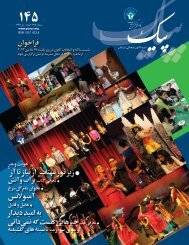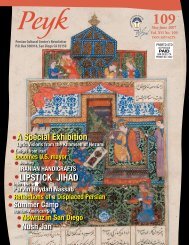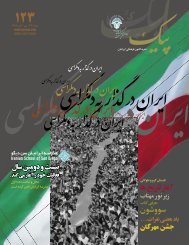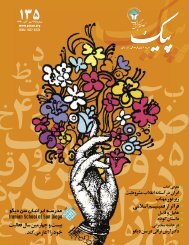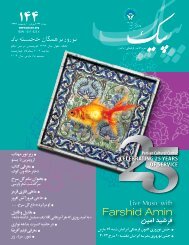Create successful ePaper yourself
Turn your PDF publications into a flip-book with our unique Google optimized e-Paper software.
ROJA NAJAFI<br />
Through Roja’s Lens<br />
Francis Bacon:<br />
Figurative in the Age of Abstraction<br />
Francis Bacon (1909-1992), the Irish painter, whose powerful<br />
works have continuously haunted our eyes since World War<br />
II, is one of the most original painters of the Twentieth<br />
Century. Bacon brought the human figure back into painting<br />
during a period in which abstraction had taken over all areas<br />
of art. (Fig.1)<br />
It was an exhibition of Picasso’s work in the late 1920s in<br />
Paris that shaped Bacon’s decision to become a painter. In<br />
1929, Bacon acquired a studio in London and started working<br />
as an interior decorator, experimenting with painting on the<br />
side. Only a few of Bacon’s paintings remain from that period<br />
as he destroyed most of his early works. The early pieces<br />
have Cubist tendencies and are comparable to the works of<br />
Fernand Léger and Picasso’s biomorphic shapes.<br />
From the 1940s onward, Bacon became a full-time painter.<br />
He quickly arrived at a style that would become his signature<br />
treatment of the human figure: columnar creatures against a<br />
monochromatic background in an empty space, like a room<br />
or a box. (Fig.2)<br />
The history of Modern Art and the process that lead to the<br />
birth of Abstraction in art started at the end of the Nineteenth<br />
Century with the elimination of narrative elements in painting.<br />
As a result, the human figure, perhaps the most crucial role<br />
in any narration, began to disappear from painting. Modern<br />
artists questioned the place of portrait painting as an apt genre<br />
for the modern time. The problem was that when one sees a<br />
face or a human figure, one at least expects an expressive<br />
notion if not a full story. That expectation dominates the<br />
formal aspects of the painting by entering the elements of<br />
narration into the painting; these are the elements, which<br />
were already removed from the painting. And that was a<br />
challenge. For example, Picasso is one of the first to confront<br />
the issues of modern portraiture. When developing Cubism<br />
(1909-1914), Picasso and Braque started by breaking down<br />
the surface of the picture into smaller fragments, layer by<br />
layer. In this manner, the naturalistic details of a face or a<br />
human body would become unrecognizable and only an<br />
outline would remain. (Fig.3)<br />
After the Second World War, Bacon challenged the problems<br />
of depicting the human body and face in Modern Art. Instead<br />
Fig.1 Francis<br />
Bacon in his<br />
studio, 1984<br />
of separating the traditional painting from the modern<br />
painting, Bacon joined the two together. His paintings<br />
are mostly based on photographs, specifically the images<br />
printed in newspapers. Bacon started by drawing a<br />
clear image based on one or a variety of photographs.<br />
At this point, Bacon was close to the realistic depiction<br />
in traditional painting. Then, however, he estranged<br />
the figures by applying paint to the canvas flatly and at<br />
the same time using strong brushstrokes. Art historian<br />
Peter Burger describes Bacon’s creative process as “the<br />
contrast between calculation and spontaneity.” Burger<br />
further describes Bacon as a painter who depicts “the<br />
individual in the moment of disintegration.”<br />
Francis Bacon brought tradition and modernity together<br />
in the depiction of figure in search of reality. He said, “I<br />
believe that realism has to be re-invented.” Bacon not<br />
only presented a new reality, but one that transforms<br />
constantly. This is perhaps the strongest point of<br />
his paintings. Bacon’s works are based on historic<br />
photographs. The photographs can be seen as proof of<br />
reality. But at the same time, they are not real because<br />
they are frozen in the time, and reality is in constant<br />
18<br />
No. 122/ July-August 2009



